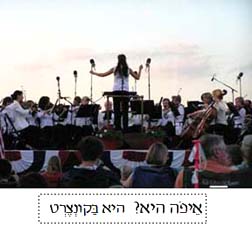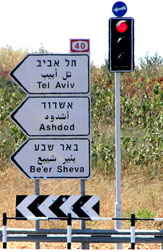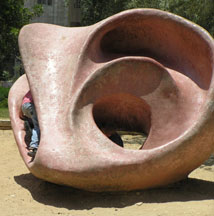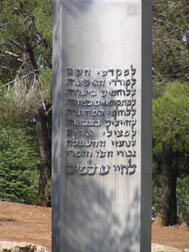אֵיפֹה, לְאן- WORDS ASKING ABOUT LOCATION AND DESTINATION - 2.11
Learn two Hebrew words for "where": אֵיפֹה and לְאן.
אֵיפֹה
is used when asking where something or someone is located. לְאן is used when asking about a destination.?אֵיפֹה אתְ? אֵיפֹה אתה - Where are you? - 2.11.1
2.11.1 בּ But first, a short introduction to the prefix
The prefix בּ can mean in, at, on, depending on the context. בּ - /bah/ includes the definite article "the" (in the, at the, etc.). (A word of explanation: The word prefix refers to a word or letters that are attached at the beginning of a word. For example, in English the word "uneven" (meaning not even) has a prefix "un."
The prefix
You will not always see the דגַש (dot) in this prefix, but since the בּ is at the beginning of a word it is always pronounced with the /b/ sound.
(Note: This prefix can also be used for the meaning "with a" or "with the" but that meaning is not part of this lesson about answering questions related to אֵיפֹה or לְאן)
100.00 %

Examples of use of the prefix בּ
He is in Tel Aviv . הוּא בְּתֵל־אביב
I'm at the university : אני בּאוּניברסיטה
הוא בּאופֶּרה He is at the opera
המוּזיאון בְּירוּשלים The museum is in Jerusalem
Reminder: the prefix ה is attached to a word which would be preceded with the word "the" in English - "the ____ . For example: "the theater" is in Jerusalem.
התֵיאטְרון בְּירוּשלים
2.11.1.2 תרגיל: תירגוּם
The vocabulary listed below uses words borrowed from
English. Read them (out loud) and decide their meaning from the way they sound.
100.00 %
תֵיאטְרון קפֶטֶרְיָה אופֶּרה מוּזֵיאון קונְצֶרט
H![]() ow would you say these sentences in Hebrew?
Hint: If
ב
means "in the" or," at the", then it should
be read
בַּ
but if the בּּ
means "in a", "at a" then it should be read
בְּ
ow would you say these sentences in Hebrew?
Hint: If
ב
means "in the" or," at the", then it should
be read
בַּ
but if the בּּ
means "in a", "at a" then it should be read
בְּ
אֵיפֹה אתה?, אֵיפֹה את?, אֵיפֹה הוּא?, אֵיפֹה היא?
1. I am at
the museum. ____________________________________________2. I am in
the theater. ____________________________________________3. The opera is
in Eilat (אילת). ____________________________________________4. The teacher is at
a museum. ____________________________________________5. The museum is
in Tel Aviv. ____________________________________________6. You (f) are in
a cafeteria. ____________________________________________7. He's at
a concert. ____________________________________________96
 לְאן
- Answer the question in Hebrew - 2.11.2
לְאן
- Answer the question in Hebrew - 2.11.2
ל A short introduction to the prefix 2.11.2.1
The prefix ל can mean to when answering questions using לְאן, i.e. "to what place"?
ל /lah/ includes the definite article "the" i.e. "to the".
לְ means "to a".
לְאן? לְבְּאֵר שֶבע? לְאשְדוד? לֹא, רינה הלְכה לתֵיאטרון.
2.11.2.2 - תרגיל תירגוּם
Example: Where did you go? ("to what place?) - ?לְאן הלכתָ? לְאן הלכתְ
Example: He went to a concert. הוּא הלך לְקונְצֶרט
(Note: You should be able to figure out how to change the citation (base) form "הוּא הלך" to the correct form for " ________ אני" for sentences one and two below. Notice that in the example above for "Where did you go" you find the correct form of the verb for "you went" even though we would translate לְאן הלכְתָ as "where did you go?".
![]()
1. I went to a museum. ____________________________________________________
2. I went to the theater. ____________________________________________________
3. You (m) went to a cafeteria. ____________________________________________________
4. She went to a university in Haifa. ____________________________________________________
5. He went to an opera in New York. ____________________________________________________
6. You (f) went to a theater. ____________________________________________________
Remember that the pronouns
הוּא and
היא must be included
with the verb
in a sentence. Including the
pronouns אני, את, אתה is optional.



אֵיפֹה היֶלֶד?
96
סיכּוּם: מה למדת?![]()
Explain the difference between the question words: אֵיפֹה, לְאן
___________________________________
____________________________
____________________________

100.00 %
 דוּ־שׂיחַ
- A Short Dialog
2.11.2.3
דוּ־שׂיחַ
- A Short Dialog
2.11.2.3
נעמה: שלום יואב, מה שלומְךָ
יואב: טוב תודה. לְאן הלכְת אֶתְמול?
נעמה: הלכְתי לְיד ושֵם.
יואב: איפֹה זה?
נעמה: בִירוּשליִם, בּהר הרְצֶל.
לְאן אתה הלכְת?
יואב: הלכְתי לתֵיאטְרון עם הדוד שלי.
נעמה: אוי - יֵש לי שיעוּר עכְשיו, להתראות.
יואב: להתראות.

97
תרגיל היגוּי - PRONUNCIATION DRILL /ee/ 2.12
Listen and Repeat Your Instructor or the audio will model the Hebrew word first. You should try to imitate that pronunciation. . As you pronounce Hebrew words remember that the Hebrew vowels must not sound like English vowels.
100.00 %
The pronunciation of Hebrew /ih/ is midway
between the /i/ of the English word "pill" and the /ee/
of "peel." Be
sure not to say "peel" or "pill" when you say
פיל
Listen to the difference between
these pairs of English and Hebrew words.

פיל גיל בימה קילו
גיר סיר כּביר
היגוּי ֵ ֶ - The sound of Hebrew /eh/ 2.12.1
The sound of Hebrew /eh/
is midway between the "e"
of "pen" and the "ai
" "pain."
Listen to the difference between
these pairs of English and Hebrew words.
Listen and Repeat!
100.00 %
פֶּן כֵּן תֵן אֵל
רֵיק שֵם לֵךְ מֵת
2.13
דיקלוּם
It is important to build a repertoire of useful Hebrew
phrases that you can produce without hesitation and that just flow
automatically. Below are some expressions to add to your repertoire. Some of these sentences use the "present tense" which
you haven't learned yet. For now, you will be memorizing these short
phrases since they are very useful.
עבודה בקבוצות
Write a short skit using at
least eight of the phrases below. You can use some English in your skit.
Name your characters, Use some of the words for locations you learned in
the precedeing exercises in your dialogue. (You are not
expected to know the grammatical forms in these phrases. Just be able to
use them in appropriate situations.)
100.00 %
98
2.14
The Hebrew verb system can be organized into
groups of verbs that have the same pattern.
We give names to each of these groups.
We will learn more about these verb groups and
their names in later chapters.
All
of the verbs that you have studied so far
belong to a group that is named
You have learned the verb forms for the singular pronouns
100.00 %
2.14
שְמות הגוּף
טבְלת פעלים
--בנְיין פעל
- Verb Chart -
2.14.2
Now study the verb forms below. In the
first column you see your citation, or base form for
הוּא
. In the next columns you will
see the way the verbs are used in their plural forms. Notice that
the masculine and feminine forms are the same for
אֲנַחְנוּ .
The plural forms for
הֵן
הֵם are
the same for both the masculine and feminine verbs
בנְיין פעל --רבּים
Two - Syllable
Verbs
2.14.2.1
בנְיין פעל--
טבְלת פעלים
Notice that there are three (3) possible
translations for each of the forms
in
the list below! So,
Note: When referring to a group of people of both
genders in the plural forms (you, they), the
masculine pronouns and verb forms are used (
Remember - There are three possible English translations for each
form of a Hebrew verb. You can use the verb
In the list below the
כּ
does not always have a דגֵש (dot)
in it. At the beginning of a word it is ALWAYS pronounced with the /k/
sound, with or without a דגֵש
in it. פָעַל
I wrote, did write, was writing
אֲנִי כָּתַ֫בְתִי
You (masc. sing.) wrote, did write, were
writing
אַתָה כָתַ֫בְתָ
You (fem. Sing.) wrote, did write, were
writing
אַתְ כָתַ֫בְתְ
He wrote, did write, was writing
הוּא כָתַב
She wrote, did write, was writing
הִיא כָתְבָה
We wrote, did write, were writing
אֲנַחְנוּ כָתַ֫בְנוּ You (masc. pl.) wrote, did write, were
writing
* אַתֶם כָתַ֫בְתֶם You (fem. pl.) wrote, did write, were
writing
* אַתֶן כָתַ֫בְתֶן They (masc. pl.) wrote, did write, were
writing
הֵם כָתְבוּ they (fem. pl.) wrote, did write, were
writing
הֵן כָתְבוּ
In formal Hebrew these forms are
כְתַבְתֶ֫ן
and כְתַבְתֶ֫ן
with the accent on the last syllable. (The red mark indicates the
accented syllable סֵ֫פֶר) 99 למלא את
החסר
- Fill in the blanks - 2.14.3 Fill in the past tense forms for the Hebrew verbs below.
Write in the vowels, matching your model verb from above. Write in the
correct English translation (learned, forgot, knew, etc.) on the lines
provided. למד (s)he
___________________________________ שכח ((s)he
___________________________________
ידע
________
(s)he
___________________________________ גר
________
(s)he
___________________________________
למד את
________ אתן
________ אֲנִי
________ אֲנַחְנוּ
________ שכח
________
את
________ אתן ________ ידע
________
את
________ אתן
________ אֲנִי
________ אֲנַחְנוּ
________ גר
________
את
________ אתן
________ אֲנִי
________ אֲנַחְנוּ
________ אנשים שֶיודְעים עִברית
- The World of Hebraists
2.14.4
Can you read the Hebrew paragraph below? It uses words you may not have
heard yet. However, using the general summary that follows and working
with hunches, you can figure out the general meaning of the passage.
Give it a try!
100.00 %
בְכל העולם יֵש אנשים הרְבֵּה אנשים למְדוּ עבְרית כי הֵם רוצים לקְרוא אֶת התנ"ךְ
100
1. למדְתי עבְרית באוּניבֶרסיטה
1. I learned Hebrew at the university
2. אני מְדבֵּר ( מְדבֶּרֶת ) עבְרית.
2. I speak Hebrew
3. אני לׂא מְדבֵּר (מְדבֶּרֶת) עִבְרית
3. I don't speak Hebrew.
4. דבֵּר ( דבְּרי ) לְאט
בְּבקשה.
4. Speak slowly please.
5. תכּיר (תכּירי) בּבקשה
אֶת
5. I'd like you to meet.
6. אני לׂא יודֵעַ (יודעת).
6. I don't know.
7. סְליחה, לׂא הֵבנְתי.
7. Excuse me, I didn't understand.
8. בִּרְצינוּת! בִּרְצינוּת?
8. Seriously?
9. אני רוצֶה לִשְתות מַיִם
9. I want a drink of water.
10. מה חדש?
10. What's new?
11. אֵין חדש!
11.There's nothing new!
12. יֵש לי
שְאֵלה.
12. I have a question.
13. אֵיך אומְרים
בְּעִבְרית?
13. How do you say ___ in Hebrew
14. מה זֶה?
14. What's this?

We (masculine and Feminine)
אנחַנוּ
You (masculine)
אַתֶּם
You (feminine
אַתֶּן
They (masculine)
הֵם
They (feminine)
הֵן
הֵן
הֵם
אַתֶּן
אַתֶּם
אֲנַחְנוּ
הוּא
לָמְדוּ
למְדוּ
לַָמַדְתֶּן
לָמַדְתֶּם
לָמַדְנוּ
לַָמד
יָדְעוּ
יָדְעוּ
יָדַעְתֶּן
יָדַעְתֶּם
יָדַעְנוּ
יָדַע
כָּתְבוּ
כָּתְבוּ
כָּתַבְתֶּן
כָּתַבְתֶּם
כָּתַבְנוּ
כָּתַב
שָכְחוּ
שָכְחוּ
שָכַחְתֶּן
שָכַחְתֶּם
שָכַחְנוּ
שָכַח
![]()
 Throughout the world there are people who have
various levels of Hebrew knowledge. Some can speak; others only read
Hebrew. Though their reasons for acquiring the language differ, as well
as the ways they have learned their Hebrew, they all have a living
connection with each other and with Israel, the center of Hebrew
language and culture.
Throughout the world there are people who have
various levels of Hebrew knowledge. Some can speak; others only read
Hebrew. Though their reasons for acquiring the language differ, as well
as the ways they have learned their Hebrew, they all have a living
connection with each other and with Israel, the center of Hebrew
language and culture.
הֶעָרָה
FYI לידיעתך
Hebrew has surprisingly few "foreign" or words borrowed from other languages The Academy of the Hebrew Language has coined many thousands of words for use in Modern Hebrew. You can visit their website! HERE
A foreign word is called מילה לועֲזית